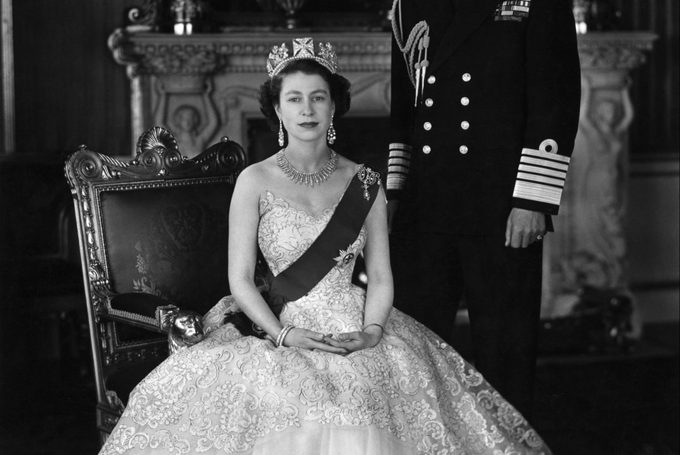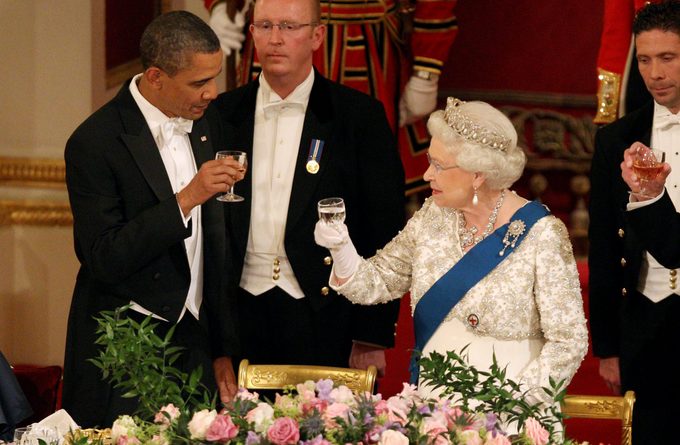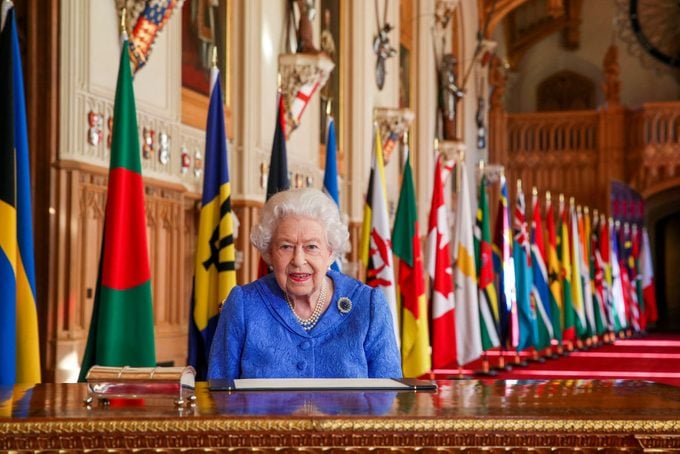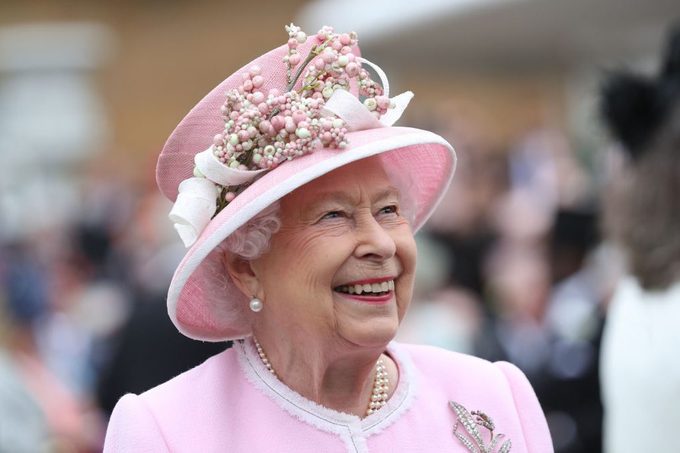A Trusted Friend in a Complicated World
1 Year for Only $10!
1 Year for Only $18!
1 Year for Only $10!
1 Year for Only $18!
RD.COM Arts & Entertainment Royal Family
Editor’s note: Queen Elizabeth II, Britain’s longest-reigning monarch, who sat on the throne for 70 years, has died at 96 years old. In a statement on Sept. 8, 2022, the Royal Family website writes, “The Queen died peacefully at Balmoral this afternoon. The King and The Queen Consort will remain at Balmoral this evening and will return to London tomorrow.” The Reader’s Digest team sends condolences to the royal family and all of Britain at this time as we honor her life and legacy.
Most Britons alive today have never known a ruler other than Queen Elizabeth II, so it’s an understatement to say that Queen Elizabeth’s death—announced by the palace on Sept. 8, 2022—rocked the country. Not only was she the longest-serving monarch, with 70 years on the throne, but she was also the most widely traveled head of state in the world, making her one of the most influential figures in modern history.
Her impact was so far-reaching and she was so beloved that the United Nations held a tribute moment of silence upon learning of her death. “Elizabeth presided over a period of historic changes, both for her country and the world,” said Nicolas de Rivière, the current council president. “Her life was devoted to the service of her country.”
It’s been seven decades since the United Kingdom has seen a change in the royal succession to the throne, so Queen Elizabeth’s death has renewed interest in the inner workings of the crown. People around the world are wondering what the queen of England even does, what happens now that the queen has died, how titles will shift across the royal family tree and whether Prince Charles will be king. (Spoiler: He already is.) Before you dive into what happens next, take a look back at the queen’s life and legacy.
Elizabeth Alexandra Mary Windsor was born on Apr. 21, 1926, and died on Sept. 8, 2022, at 96 years old. She passed away peacefully at Balmoral Castle in Scotland, surrounded by loved ones, according to a statement from the royal family.
Her death, while tragic, did not come as a surprise. The queen had been ailing ever since her husband of 73 years, Prince Philip, died in April 2021. There were even rumors of Queen Elizabeth stepping down.
In October 2021, she was admitted to the hospital for unknown health complications, and in November, she sprained her back and returned to the hospital. In February 2022 she contracted COVID-19, and by August was bowing out of events citing “mobility issues” and “physical discomfort.”
When a photograph of her meeting with new British prime minister Liz Truss revealed a large bruise on the back of her hand, public speculation about her health only grew. And while it may not have come as a complete shock when, two days later, the royal family announced Queen Elizabeth II’s death, it still rocked the nation and the world.
“We mourn profoundly the passing of a cherished Sovereign and a much-loved Mother,” said a statement from the new monarch, King Charles III. “During this period of mourning and change, my family and I will be comforted and sustained by our knowledge of the respect and deep affection in which The Queen was so widely held.”
As Britain’s longest-reigning monarch, Elizabeth sat on the throne for 70 years, from 1952 until her death in 2022.
On Feb. 6, 1952, after the death of Queen Elizabeth’s father, King George VI, the then-25-year-old was crowned in an elaborate coronation ceremony. It was the first televised British coronation, and that unprecedented access to the royals helped endear her to so many people worldwide.
Queen Elizabeth and Prince Philip ruled alongside 15 prime ministers, including newly elected Liz Truss, who the queen formally appointed on Sept. 6, just two days before her passing. During her reign, Elizabeth met with five popes and worked alongside six archbishops of Canterbury. An impressive 14 U.S. presidents were elected during her tenure, and she met 13 of them. (Elizabeth never met Lyndon Johnson.)
Her seven decades of rule saw many major events and milestones in the United Kingdom and around the world. Some of the historic moments during Queen Elizabeth’s reign include six major wars (including World War II), the decolonization of Africa, the moon landing, the formation of the European Union, the return of Hong Kong to China, the introduction of the internet (and all the life-changing technology that came from it), the fall of the Berlin Wall, Brexit and the COVID-19 pandemic. But that’s far from an exhaustive list of the history Elizabeth witnessed.
What is Elizabeth’s biggest achievement? If you find yourself stymied, it’s likely because there are so many that it’s nearly impossible to choose all her accomplishments. Here are a few impressive highlights.
In 1945, the future Queen Elizabeth became the first female member of the royal family to join the armed services as a full-time active member, joining the Women’s Auxiliary Territorial Service, where she served as a driver and a mechanic.
This cemented her image as a royal of the people, not just over them. It’s something the British people came to know and love her for throughout her reign.
When she first took the throne, the British Empire—once regarded as the largest on earth—was rapidly collapsing. Even though she was still in her 20s, Elizabeth rallied world leaders to join the Commonwealth, allowing countries to maintain their independence but still work together. Under her leadership, this association of sovereign states went from eight members to the 54 members it is today.
When she started, the British monarchy was seen as aloof and out of touch, and it was in danger of becoming irrelevant. With her “walkabout” foreign tours and smart use of media, she single-handedly turned that around.
Elizabeth was on the forefront of technology, using radio, television, print and eventually the internet and social media to share a uniquely personal glimpse into the royal family and government. Not only did she reach more of her subjects this way, but she also turned many people around the world into fans.
Considering the riff between England and the colonies happened centuries ago, you might’ve assumed monarchs had paid a visit to the hallowed halls of Congress before Elizabeth became queen. But that’s a royal family myth. In May 1991, Queen Elizabeth was the first British monarch to address the U.S. Congress, cementing the countries’ strong alliance. After giving her speech, she received three standing ovations, and she is credited with the warm and friendly relationship the two nations have enjoyed since.
In 2013, she introduced the Succession to the Crown Act, which allowed for the crowning of the eldest child in line for the throne—whether boy or girl. This eliminated centuries of favoring men and gave women a clear place in British royalty and politics. Remember, she herself became queen only because she had no brothers.
Like any world leader, Elizabeth faced plenty of criticism and upheaval. Perhaps the most famous scandal during her tenure had to do with the marriage, divorce and death of Princess Diana—aka the people’s princess.
When Prince Charles married Diana Spencer, the queen was supposedly displeased. But things only got more tense when Charles divorced Diana. Then in 1997, Princess Diana died tragically in a car accident, and the queen stirred more controversy by refusing to fly the flag at half-mast in her honor. (She eventually relented and made a lovely statement in tribute to Diana.)
But while the drama surrounding Queen Elizabeth and Princess Diana may have been the biggest scandal, it certainly wasn’t the only one. Here are a few of the controversies Elizabeth experienced during her reign:
Prince Harry—one of Queen Elizabeth’s grandchildren—and his wife, Meghan Markle, stepped down from royal life in 2020. The couple moved to Canada, in part due to racism Markle experienced from the royal family.
Of course, we’ll never know exactly what went down behind closed doors. Publicly, Elizabeth stayed mum, and the couple named their daughter “Lilibet,” a nod to Elizabeth’s childhood nickname.
Elizabeth’s third child was forced to step down from his royal duties after being accused of sleeping with a teenage victim of Jeffrey Epstein’s sex-trafficking scandal. Though the victim sued Prince Andrew, the U.S. sexual assault case was settled out of court.
“The horrible year” was Elizabeth’s term for 1992, the year three of her four children divorced and Windsor Castle nearly burned down. That alone would have been enough, but the events sparked international controversy about the royal family’s double standards on extramarital affairs and the extreme wealth of the monarchy—and of Elizabeth personally. (She was supposedly worth around $430 million dollars at the time of her death.) One look at the queen’s body language that year, and it’s clear she truly considered it an “annus horribilis.”
For all the good Elizabeth did, she still served as the monarch of an empire with a history of colonizing and repressing people of other nations, and her massive wealth is a direct result of that. In the wake of Queen Elizabeth’s death, many people—especially those from African nations that were once under British rule—are pointing out that the queen wasn’t universally beloved.
Reporting for CNN, international correspondent Larry Madowo reminded viewers that Elizabeth was on the throne when the British brutally subdued the anti-colonial Mau Mau movement in Kenya, herding Kenyans into detention camps. It wasn’t the only time the British suppressed anti-colonial rebellions.
In the past decade or so, there’s been a call for Britain to acknowledge and, in some cases, make payments for the empire’s legacy of colonialism. And while Elizabeth didn’t reign during all of them—and the queen is largely a figurehead—she represented the empire that committed such actions.
The public saw Elizabeth as slow to act on climate change, one of the largest controversies in the world right now. She couldn’t enact climate change laws herself, but during her reign, many wished she was more proactive in sharing her views.
Her stance on staying mum had shifted in recent years, however. In 2021, just before the UN Climate Change Conference in Glasgow, she was caught on mic criticizing world leaders for their lack of action.
The late queen was a gifted speaker and writer. Like quotes by Princess Diana, the powerful words uttered by the queen will help her legacy live on.
“It has always been easy to hate and destroy. To build and to cherish is much more difficult.”
“I cannot lead you into battle. I do not give you laws or administer justice, but I can do something else: I can give you my heart and my devotion to these old islands and to all the peoples of our brotherhood of nations.”
“Religion and culture are much in the news these days, usually as sources of difference and conflict rather than for bringing people together. But the irony is that every religion has something to say about tolerance and respecting others.”
“The birth of a baby brings great happiness—but then the hard business of growing up begins.”
“When life seems hard, the courageous do not lie down and accept defeat; instead, they are all the more determined to struggle for a better future.”
“Although we are capable of great acts of kindness, history teaches us that we sometimes need saving from ourselves—from our recklessness or our greed.”
“Perhaps we make too much of what is wrong and too little of what is right. The trouble with gloom is that it feeds upon itself, and depression causes more depression.”
“We know the reward is peace on earth, goodwill toward men, but we cannot win it without determination and concerted effort.”
Elizabeth had a way with words, a wry sense of humor and impeccable timing. These are some of the funniest things she ever said.
Talk about a royal family moment made hilarious by the queen’s dry sense of humor: When a woman told her she “looked just like the queen,” Elizabeth responded, “How reassuring!”
When a gardener at the 2016 Chelsea Flower Show told her that lilies of the valley can be poisonous, she said, “I’ve been given two bunches this week. Perhaps they want me dead.”
During an argument, the queen mother challenged the younger royal, “Who do you think you are?” Elizabeth’s response? “The queen, mummy, the queen.”
In 2007, when then-President George W. Bush accidentally said the queen helped the United States celebrate its bicentennial in 1776 (instead of 1976), the queen remarked, “I wondered whether I should start this toast by saying, ‘When I was here in 1776 …’”
When you think of the queen of England, you probably have a very clear image in your head—and that image likely came from Elizabeth. She was a noted style icon, not necessarily for her adventurous choices, but rather for her consistently polished style. Her wardrobe mostly consisted of structured dresses and suits with skirts, all in bright colors with impeccably matched hats, white gloves and handbags.
Her hair was always coiffed and her makeup subtle. (To our knowledge, she was never once spotted in her pajamas with her hair in a bun and smudged mascara. Unlike us commoners.)
One quirky fashion choice she will be remembered for is her devotion to pantyhose or nylons. Not only did Elizabeth wear them anytime she went out in public, but she also required those around her to wear them as well. This continued into modern times, decades after the rest of the world had mostly given them up as impractical and unfashionable.
Her other hallmark was her unmatched collection of jewelry: tiaras, broaches, rings, necklaces and bracelets that were sparkly, large and priceless.
Over the years, Elizabeth met hundreds of celebrities and even knighted a few (like Sir Elton John). She and Marilyn Monroe were exactly the same age and met in 1956. She often sprinkled these celebrity meetings with her dry wit, once famously asking legendary guitarist Eric Clapton “Have you been playing for a long time?”
But perhaps her most memorable meeting was with Bond, James Bond, the (fictional) British superspy. Elizabeth met all the actors who played James Bond in movies but took a special liking to Daniel Craig—who wouldn’t?—and asked him to escort her to the opening ceremony of the 2012 London Olympic Games.
Shortly after Queen Elizabeth’s death, her eldest son, Charles, became the new ruler, King Charles III. He immediately took over the royal duties, continuing where his mother left off. As an interesting side note, in February 2020, Elizabeth came out in support of Camilla Parker-Bowles, Charles’s second wife, becoming the queen consort when Charles became king.
Of course, the new king is already 73 years old, furthering interest in the line of succession. When he dies or retires, his older son, Prince William, will become the next king. The longtime Duke of Cambridge inherited his father’s former titles, Duke of Cornwall and Prince of Wales.
After the 40-year-old prince, the next in line for the throne is his oldest child, Prince George, who’s currently 9 years old. Charles and his heirs have big shoes to fill (metaphorically speaking—Elizabeth reportedly had size 4 feet!). But the queen left them everything they need to be successful world leaders, just like her.
Sources:
Our Brands
We are no longer supporting IE (Internet Explorer) as we strive to provide site experiences for browsers that support new web standards and security practices.
We recommend our users to update the browser.